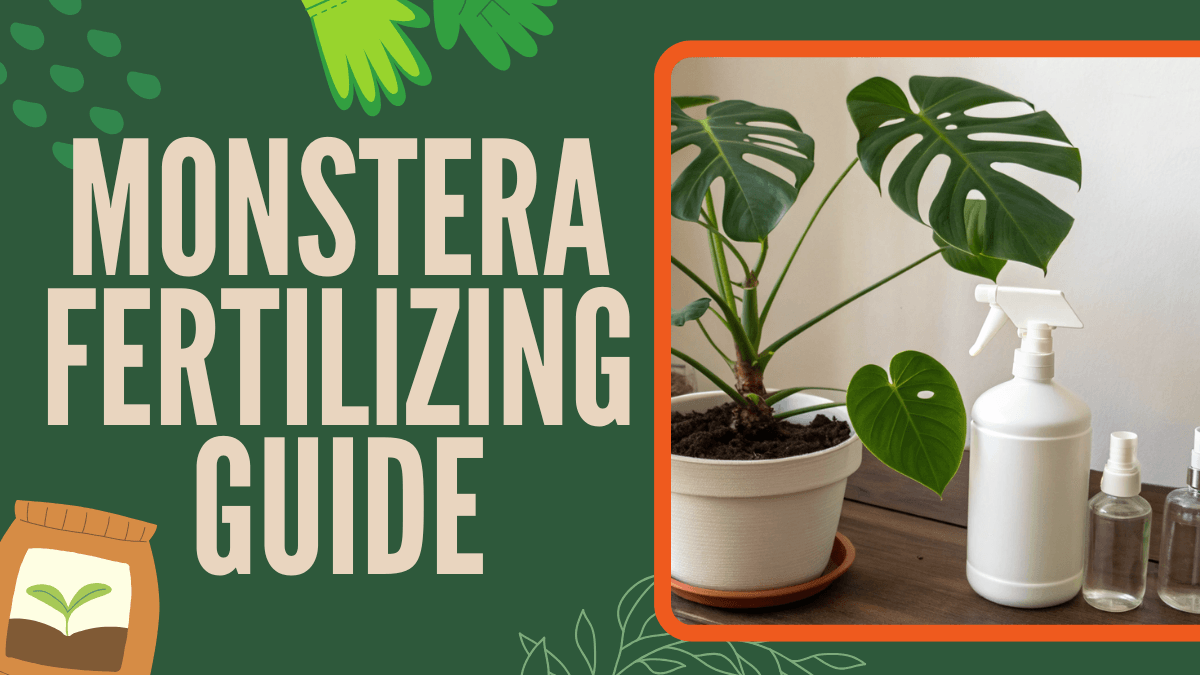Monstera fertilizing is one of the most important parts of keeping this tropical beauty healthy and vibrant. If your Monstera’s leaves are losing their lush green glow or new growth seems slow, the right fertilization routine could be the missing piece.
Monstera are heavy feeders, but they rely on us in indoor settings to provide the nutrients that tropical rainforest soil normally supplies. Fertilizing at the wrong time or with the wrong formula can do more harm than good.
Table of Contents
Why Monstera Fertilizing Matters

Monstera (Monstera deliciosa and other varieties) are considered heavy feeders because of their fast-growing nature. In the wild, they climb trees and absorb nutrients from decaying organic matter in the rainforest floor. Indoors, that natural buffet disappears – so fertilizing becomes crucial.
But here’s the trick: it’s not just about feeding your Monstera, it’s about feeding it at the right time.
Monstera have a natural growing cycle. During spring and summer, they enter an active growth phase where new leaves, roots, and aerial roots develop. This is when they’re hungry for nutrients and can use them efficiently.
In fall and winter, growth slows, and the plant doesn’t need much feeding. Overdoing it during these months can actually harm your plant.
In short:
- Fertilize regularly from March to September.
- Reduce or stop feeding from October to February.
Timing matters as much as the fertilizer itself. Overfeeding in the dormant months is one of the top reasons Monstera develop yellow leaves or burnt tips.
Key Nutrients for Monstera Fertilizing
Every fertilizer label includes three numbers like 20-20-20 or 5-2-3 – these represent the N-P-K ratio, which stands for Nitrogen (N), Phosphorus (P), and Potassium (K). Understanding these helps you pick the right fertilizer for your Monstera’s needs.
- Nitrogen (N): The growth booster. Nitrogen fuels leaf and stem development, giving Monstera that lush green color and large leaf size.
- Phosphorus (P): Essential for root development and flower or fruit growth (though Monstera rarely bloom indoors, strong roots mean a stronger plant overall).
- Potassium (K): Supports overall health, disease resistance, and sturdier stems.
A balanced fertilizer, such as 20-20-20 or 10-10-10, is usually ideal for Monstera. However, if your plant is mostly producing new leaves but lacks size or splits, you might try a slightly higher nitrogen ratio, like 3-1-,2 for a boost.
Remember: It’s not about using the strongest fertilizer, it’s about maintaining consistency and balance.
Types of Fertilizer for Monstera
Fertilizers come in different forms, and the best one for your Monstera depends on your lifestyle and how much attention you like to give your plants.
1. Liquid Fertilizer

Liquid fertilizers are the most popular choice for indoor Monstera. You dilute them in water and apply while watering. The nutrients are absorbed quickly, and you can easily adjust the dose.
- Best for: Plant parents who water regularly and like to monitor their Monstera’s growth.
- Example formula: A balanced 20-20-20 liquid fertilizer applied every 2–4 weeks during active growth.
2. Slow-Release Fertilizer

These come as pellets or granules that you mix into the soil. They release nutrients gradually over several months, making them a great low-maintenance option.
- Best for: Busy people or frequent travelers.
- Tip: Apply once in early spring and again in mid-summer.
3. Organic Fertilizer

Organic options like worm castings, fish emulsion, or compost provide nutrients naturally and improve soil texture. They’re gentler on roots and help foster beneficial microbes.
- Best for: Eco-friendly gardeners or anyone who prefers natural care routines.
No matter which type you choose, always follow the “less is more” rule. It’s easier to correct underfeeding than to fix overfertilization damage.
Seasonal Monstera Fertilizing Schedule
Fertilizing your Monstera on a seasonal cycle mimics nature and helps your plant stay in rhythm.
Spring (March–May)
Your Monstera is waking up and starting to grow again. Begin feeding with a diluted balanced fertilizer once every two weeks. This supports new root and leaf development.
Summer (June–August)
This is the peak growing season! Continue fertilizing every 2–3 weeks. You can even switch to a formula with a slightly higher nitrogen content for extra leaf growth.
Fall (September–October)
Gradually reduce feeding to once a month, then taper off as the plant’s growth slows. This helps prepare your Monstera for rest without shocking its system.
Winter (November–February)
Your Monstera enters dormancy, no fertilizer needed. Focus on stable conditions: bright indirect light and consistent watering. Feeding during this time can lead to salt buildup and root burn.
(If you’re wondering about where to place your Monstera for optimal growth throughout the year, check out these placement ideas for Monstera.)
Common Fertilizing Mistakes (and How to Avoid Them)

Even experienced plant owners can make fertilizing mistakes. Here are the most common ones to watch out for:
1. Overfertilizing
Adding too much fertilizer can cause leaf burn, where the tips turn brown and crispy. It happens because excess salts build up in the soil and damage roots.
Fix: Flush the soil with clean water once a month to remove salt buildup, and always dilute your fertilizer more than the label recommends.
2. Fertilizing During Dormancy
Feeding your Monstera in winter can stress it out. It’s like forcing it to eat while it’s sleeping; the roots won’t absorb the nutrients properly.
3. Using the Wrong Formula
Avoid fertilizers meant for lawns or outdoor shrubs. They’re often too strong and contain minerals not suited for indoor plants.
4. Skipping Feedings Altogether
Monstera can survive without frequent fertilizing, but they won’t reach their full potential. Consistent feeding leads to larger leaves, deeper color, and faster growth.
(You can also read about common Monstera care mistakes to make sure you’re avoiding other pitfalls beyond fertilizing.)
DIY Natural Fertilizer Options
If you love a natural or budget-friendly approach, you can make your own Monstera fertilizer with ingredients you probably already have at home.
1. Banana Peel Fertilizer
Banana peels are rich in potassium and phosphorus, two nutrients Monsteras adore.
How to use:
- Chop up banana peels and bury them in the soil (not too deep).
- Or make banana peel tea: soak peels in water for 48 hours, then use that water to feed your plant once a month.
2. Compost Tea
Compost tea is a mild, nutrient-rich solution that feeds both your plant and the beneficial microbes in its soil.
How to make:
- Add one cup of mature compost to a bucket of water.
- Let it steep for 24 hours.
- Strain and water your Monstera with the liquid.
3. Eggshell Powder
Crushed eggshells add calcium to the soil, preventing weak or curling leaves.
How to use: Rinse, dry, and crush eggshells into a fine powder, then mix a small amount into the topsoil every few months.
4. Worm Castings
This is one of the best all-natural fertilizers for Monstera. Worm castings release nutrients slowly and improve soil aeration. Mix a handful into your potting mix during repotting or sprinkle on top as a gentle feed.
Conclusion
Fertilizing your Monstera doesn’t have to be complicated; it’s all about timing, balance, and consistency.
- Feed during the growing season (spring–summer).
- Use a balanced N-P-K fertilizer or a gentle organic alternative.
- Avoid overfeeding and give your plant a rest in winter.
When done right, you’ll notice your Monstera pushing out larger leaves, richer color, and that irresistible tropical vibe every plant parent dreams of.
Your Monstera’s health isn’t just about what you feed it; it’s also about how you listen to it. With the right balance of nutrients and care, your Monstera will reward you with the stunning, jungle-inspired beauty that makes it one of the most beloved houseplants in the world.


 ChatGPT
ChatGPT
 Perplexity
Perplexity
 Claude
Claude
Leave a Reply